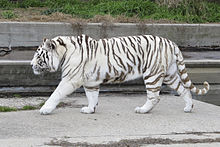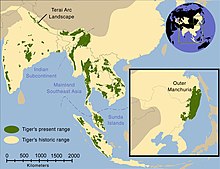For other uses, see White tiger (disambiguation).
The white tiger is a pigmentation variant of the Bengal tiger, which is reported in the wild from time to time in the Indian states of Assam, West Bengal and Biharin the Sunderbans region and especially in the former State of Rewa.[1] Such a tiger has the black stripes typical of the Bengal tiger, but carries a white or near-white coat.
Variation
The white Bengal tigers are distinctive due to the color of their fur. The white fur caused by a lack of the pigmentpheomelanin, which is found in Bengal tigers with orange color fur. When compared to Bengal tigers, the white Bengal tigers tend to grow faster and heavier than the orange Bengal tiger. They also tend to be somewhat bigger at birth, and as fully grown adults. White Bengal tigers are fully grown when they are 2–3 years of age. White male tigers reach weights of 200 to 230 kilograms and can grow up to 3 meters in length. As with all tigers, the white Bengal tiger’s stripes are like fingerprints, with no two tigers having the same pattern. The stripes of the tiger are a pigmentation of the skin; if an individual were to be shaved, its distinctive coat pattern would still be visible.[2] For a white Bengal tiger to be born, both parents must carry the unusual gene for white colouring, which only happens naturally about once in 10,000 births.[2]Dark-striped white individuals are well-documented in the Bengal tiger subspecies (Panthera tigris tigris) as well as having been reported historically in several other subspecies.[2] Currently, several hundred white tigers are in captivity worldwide, with about one hundred being found in India. Their unique white color fur has made them popular in entertainment showcasing exotic animals, and at zoos.




